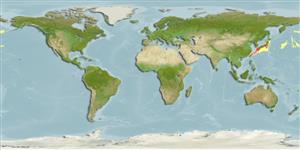Environment: milieu / climate zone / depth range / distribution range
Ekologi
marina batypelagisk; djupintervall 336 - 605 m (Ref. 9869). Deep-water
Northwest Pacific: along the southern coast of Japan (south of Tokyo), in Sagami and Suruga Bays and in the Sea of Japan (Ref. 9869).
Size / Vikt / Age
Maturity: Lm ? range ? - ? cm
Max length : 12.6 cm SL hane/ej könsbestämd; (Ref. 9869)
Life cycle and mating behavior
Könsmognad | Reproduktion | Lek | Ägg | Fecundity | Larver
Kotlyar, A.N., 1986. Systematics and distribution of species of the genus Hoplostethus Cuvier (Beryciformes, Trachichthyidae). Trudy Inst. Okeanol. 121:97-140. (Ref. 9869)
IUCN Red List Status (Ref. 130435)
Threat to humans
Harmless
Human uses
Fiskeri: saknar intresse
Ytterligare information
PopulärnamnsynonymerMetabolikPredatorerEkotoxikologiReproduktionKönsmognadLekSpawning aggregationFecundityÄggEgg development
Age/Size
Tillväxt
Length-weight
Length-length
Length-frequencies
Morfometri
Morfologi
Larver
Larvdynamik
Rekrytering
Abundans
BRUVS
referenserVattenbrukVattenbruksprofilAvelslinjerGenetikElectrophoresesÄrftlighetSjukdomarBehandlingNutrientsMass conversion
Verktyg
Special reports
Download XML
Internet-källor
Estimates based on models
Preferred temperature (Ref.
123201): 8 - 12.9, mean 9.7 °C (based on 19 cells).
Phylogenetic diversity index (Ref.
82804): PD
50 = 0.5000 [Uniqueness, from 0.5 = low to 2.0 = high].
Bayesian length-weight: a=0.01660 (0.00723 - 0.03808), b=3.05 (2.85 - 3.25), in cm total length, based on LWR estimates for this (Sub)family-body shape (Ref.
93245).
Trofisk nivå (Ref.
69278): 3.4 ±0.5 se; based on size and trophs of closest relatives
Resiliens (Ref.
120179): Låg, lägsta populationsfördubblingstid 4,5-14 år (Preliminary K or Fecundity.).
Fishing Vulnerability (Ref.
59153): Low vulnerability (10 of 100).
